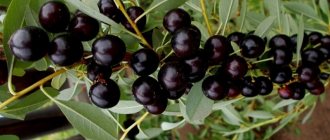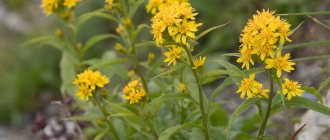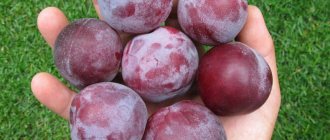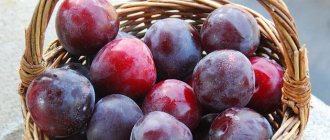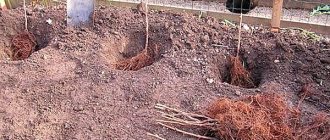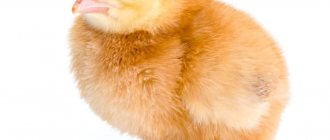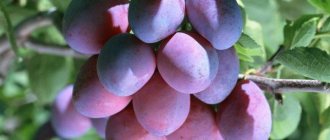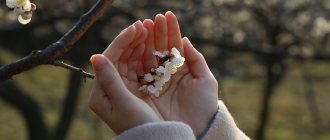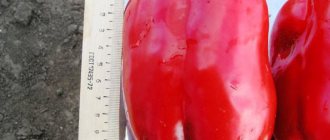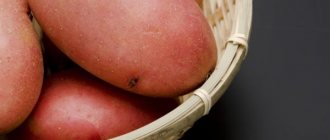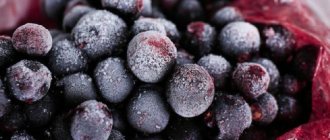Stanley plum belongs to the popular subspecies of domestic plum - Hungarian plum. This American variety has remained in demand for more than a hundred years. Russian gardeners have known Stanley for 30 years. Let's find out why this variety is attractive and in which regions it can be grown.
Stanley plum variety
Hungarian plum "Stanley"
"Stanley" is one of the best quality fruits
Where did the plum variety come from?
Stanley is of American origin - the variety was bred in the USA at the beginning of the 20th century by crossing the "Ajan" Hungarian and the "Grand Duke". The variety was registered in the State Register of Russia in 1983. It was zoned only in the North Caucasus region, but due to its high frost resistance, Stanley is also grown in more northern regions.
Stanley is classified as a subspecies of the Hungarian. He took the best from his parents - large fruit (from “Duke”) and abundant fruiting (from “Azhanskaya”). Today, Stanley plum is often used as a donor of valuable agrotechnical characteristics - the variety is widely used for breeding.
Characteristics of plum
The positive characteristics of the Stanley plum variety include many significant points.
- High winter hardiness. Trees tolerate frosts down to -34 degrees Celsius.
- There is immunity to sharka and polystigmosis. And the resistance to moniliosis is average.
- Productivity. Each tree can produce 50-60 kg of harvest if the plum tree is properly cared for.
- Stanley plum fruits can easily be transported over long and short distances.
- Precociousness.
- Large fruits.
- Excellent fruit taste.
The Stanley plum variety is very resilient. She can survive in frost or heat
In addition to its positive qualities, Stanley plum has a couple of negative characteristics.
- If a tree is not treated with insecticides on time, it may be attacked by aphids and other pests several times a season. This is a lot of stress for the tree, and if no countermeasures are taken, in a few years it will simply stop giving birth.
- Stanley plum does not tolerate drought well.
Description of Stanley
Botanical and agrotechnical features:
- Tree. About 3 m high, with a round-oval crown and an even stem. The shoots are weakly thorned.
- Fruit. Asymmetrical, oval-elongated, with an elongated neck. The dark purple skin, with brown subcutaneous dots, is covered with a thick layer of waxy coating. The seam is clearly visible. Average weight is 40 g. Particularly large specimens reach 60-100 g. The yellow, loose pulp has a granular-fibrous structure. The skin fits tightly to the pulp. The bones are oblong, with pointed ends. In ripe fruits, the seeds are removed without effort; in unripe plums, it is more difficult. The fruits are formed on last year's growths or on bouquet-type branches.
- Leaves. 7-8 cm long, 5 cm wide, round, bright green. The edges of the leaves are jagged.
- Flowers. Large - about 3 cm in diameter. Saucer-shaped, white, smooth petals.
- Pollination. The variety is partially self-fertile - it needs pollinators for high productivity.
- Precociousness. The first harvest is in the 4th year after planting the seedling.
Why Stanley is appreciated:
- High commercial quality. The tree produces many large and tasty fruits that tolerate transportation well. The combination of these qualities makes Stanley an ideal commercial variety.
- The versatility of the fruit. Stanley, as befits a Hungarian, is distinguished by the sweetness of the fruit. Professional tasters rated their taste at 4.7-4.8 points. They contain almost 14% sugar and 0.71% acids. Stanley plums are suitable for any purpose - they can be eaten fresh, canned, frozen, and most importantly, made into prunes.
Evaluations of tasters of Stanley fruits and products made from them:
| What was assessed? | Taster rating in points (max – 5) |
| Fresh fruits | 4,7 |
| Frozen fruits | 4,8 |
| Prunes | 4,5 |
| Juice | 4,6 |
| Canned fruits | 4,5 |
| Compotes | 5 |
Description of the variety
The late-ripening Stanley plum variety was bred a long time ago - in 1912 in the USA.
Sometimes, due to a misreading of its English name Stanley, this plum is called Stanley or even Stanley.
By type it is related to Hungarian plums.
The trees are medium-sized and have a rather sparse, rounded crown. The stem and trunk are straight, covered with medium flaky, slightly cracking dark gray bark. The shoots are colored crimson-violet and have sparse spines. Green leaves with a glossy surface and jagged edges are medium in size. Flowering occurs in the middle period (mid-April). Each flower bud produces 1–2 very large flowers (diameter 30–31 mm) on a very long pedicel. Fruit formations are formed on bouquet branches and growth from the previous year.
Stanley fruits are universally used, they are good in any form
The fruits of the Stanley plum are very large (average weight - 40–45 g, maximum - 50 g), unequal, obovate in shape and covered with a thick waxy coating. The main color is green, the outer color is dark purple. The peel is medium thick, difficult to separate. The pulp is yellow, aromatic, medium-juicy, dense, with a granular-fibrous consistency. The taste is sweet with slight sourness. It has a high content of sugars - about 13.8%, ascorbic acid - 8.9 mg per 100 g. The large stone (3 cm in length) is freely separated from the pulp.
In most cases, prunes are made from plums of this particular variety.
Video: Stanley variety
What qualities does a plum have?
Stanley is an old proven variety. Since the discovery of the variety, dozens of new varieties with improved characteristics have appeared. But the Hungarian plant of American selection is still in demand among both amateur gardeners and breeders. The reason for this situation is Stanley’s excellent agrotechnical characteristics.
An overview of the Stanley variety can be seen in the video below:
Productivity
Stanley is an extremely productive variety; even among Hungarians, famous for their abundant fruiting, it stands out noticeably for its productivity. Gardeners collect 50-60 kg of fruits from one tree. True, in order to produce such harvests, the tree needs an optimal agricultural background and fertile soils. During industrial cultivation, the yield of the variety is 18 tons per 1 ha.
Drought resistance
The variety is not drought-resistant; its ability to resist drought is at an average level. To get a generous harvest of large plums, Hungarian Stanley should not be left without water in dry summers. If you do not water a tree, its fruits become tasteless and fall off en masse.
Frost resistance
The variety is not extremely frost-resistant. It belongs to the medium category, the maximum short-term frosts that the Stanley plum can withstand without damage is minus 34 °C, long-term frosts are minus 25 °C. Regions where winter temperatures fall below this mark are contraindicated for American plums.
Resistance to diseases and pests
The variety is resistant to sharka - one of the most dangerous diseases, holey and red spotting (clusterosporiasis and polystigmosis). The most dangerous disease for this Hungarian is moniliosis (gray rot), and Stanley is also often attacked by plum aphids.
The need for pollination
Being a partially self-fertile variety, Stanley needs pollinating varieties. With partial self-fertility, only 5-15% of all formed fruits are formed, the rest is due to cross-pollination. If there are no pollinating trees nearby, Stanley will produce a crop, but pollinators flowering at the same time as it will significantly increase the tree's yield.
The best pollinators for Stanley are plums:
- Empress;
- Bluefree;
- Chachak Lepotica.
Harvesting and processing
The Stanley variety is very productive. Despite the height of the tree, up to 60 kg of fruit can be collected from it per season. The crop is usually harvested from a ladder or with special devices.
Important!
It is recommended not to pull the pagons down during harvesting. The bark of this plum variety is fragile, not elastic and can easily crack. Thus, thin and even thick branches often break!
The Stanley plum harvest can be used for fresh consumption and sale. In addition, this plum is suitable for canning either whole or in pieces, due to its dense pulp. The fruits make delicious compotes, juices, jams and sauces. This variety is often frozen in halves or slices for the winter, or dried to be used in winter for making fresh compotes or fruit tea.
Does the variety have any disadvantages?
We have already figured out that the variety does not tolerate drought well, compared to many Hungarians, and is affected by aphids and moniliosis. Stanley has one more drawback - he is very picky about soil. To produce a lot of tasty fruits - ideal raw materials for prunes, the variety needs not only moisture, but also fertilizing.
Stanley literally “pulls” nutrients from the soil. The gardener has to make up for the deficiency by constantly feeding the “voracious” plum. If Stanley is deprived of organic and mineral support, its fruits become smaller and become sour. Also, with a nutritional deficiency, the resistance to gray rot decreases.
Pollinators for Stanley plum
The Stanley plum itself can produce a harvest; it is a self-fertile species. However, its yield is small in this case; the harvest may be enough for household needs, conservation, but no more. If the plum is grown for sale, one or more pollinating varieties must be planted nearby. This will increase the productivity of Stanley by 1.5-2 times.
Read also Butterfly on a flower photo
Good pollinators for this plum are the following varieties: Empress, President, Lepotika, Voloshka, Chachakskaya, Bluefry.
When watering 1 tree, an average of 10 liters of water is consumed
All about Stanley's landing
Stanley has requirements regarding growing location, soil characteristics and timing. In order for the seedling to take root safely, grow and develop, it is necessary to take into account all the features of planting.
Climate and conditions
Stanley plum, having average frost resistance, is intended for cultivation in areas with warm or moderately cold winters. This variety is successfully cultivated not only in the southern regions of the country, but also in the middle zone. When moving north, the plum may freeze out during prolonged frosts.
Optimal planting dates
In the southern regions, seedlings can be planted at any time - in spring or autumn. But in the middle zone, preference is given to spring, since seedlings planted in autumn often do not have time to get stronger for wintering.
Landing dates:
- Spring. Planting is done before sap flow begins. Preferably immediately after the snow melts.
- Autumn. A month and a half before the onset of persistent frosts.
If a seedling is purchased late in the fall, and there is no point in planting it before winter, planting is postponed until spring. The seedling is “preserved” - buried in the ground, covered with spruce branches, and later with snow. It is removed from the trench in the spring - before planting.
Landing site and its preparation
Requirements for the Stanley plum planting site:
- Good sun exposure. The surface is flat or slopes to the south/southwest.
- No drafts or gusts of wind.
- The groundwater level is no closer than 1.5 m to the surface.
- Fertile soils with a neutral reaction. Plums do not grow well on heavy clay soil; it needs fertile sandy loam or loam with good drainage properties.
Low-lying areas are not suitable for plums - moisture accumulates here, which contributes to rotting of the bark.
The soil and hole for planting are prepared in advance, preferably in the fall - if planting is in the spring. For autumn planting, the hole is prepared 2 weeks in advance. Prepare the soil before frost. Stanley's trees are large; they need a feeding area of at least 8-10 square meters. m. The recommended planting pattern is 3x4 m.
The size of the hole depends on the fertility of the soil. Preparing holes on different soils:
- Fertile soils. Planting holes on fertile soils are dug 60 cm deep and 80 cm wide. The top layer is removed and set aside. Mix it with humus (1:1) and pour it into a hole in which the bottom has previously been dug.
- Poor soils. Here the pits are made larger to accommodate the nutritious soil mixture. The dimensions of the pit are 100x100 cm. Remove the turf, chop it up, mix it with manure (2 buckets) and ash (1 l) - the mixture is placed in the pit. In another place, they take fertile soil to fill it up, filling the hole halfway.
During planting, the following is placed in the hole:
- humus or compost – 7-10 kg;
- superphosphate – 100 g;
- potassium salt – 20-30 g, or wood ash – 200 g.
On poor soils the above doses are doubled.
Stanley, like other Hungarians, will not grow well in acidic soils. If the pH does not meet the requirements, add an additional 700 g of dolomite flour or pour a liter jar of eggshells into the soil mixture prepared for the planting hole.
The hole prepared for planting must be covered - for example, with a slate sheet, plastic film, roofing felt, or other waterproof material.
Selection and preparation of seedlings
When choosing a seedling, take into account the climatic features of the region. In areas with a warm climate, self-rooted seedlings can be planted; in colder regions, seedlings on rootstocks are preferable.
Signs of a healthy seedling:
- The roots must be in impeccable condition - without damage, rot or traces of fungus. Preference is given to seedlings with a dense and long root system.
- The branches are intact, strong, flexible. There should be no dry or damaged areas on them.
The optimal age of a seedling for planting is 1-2 years. There shouldn't be any leaves on it.
If the seedling is purchased in a container, then it is removed from it and moved directly with a lump of soil into the planting hole.
Preparing a seedling for planting:
- It is recommended to place the roots of the seedling in a solution of potassium permanganate a couple of days before planting. The solution temperature is room temperature. One of the root formation stimulants is also added there. The roots of the seedling can also be treated with “Heteroauxin” - this drug improves the survival rate of the plant. After crushing two tablets, pollinate the horse system with the resulting powder. You can also treat the roots with Epin, Kornevin, and potassium humate.
- 3-4 hours before planting, the roots of the seedling are dipped into a mash of manure and clay. The mixture should have a creamy consistency and should not drip from the roots.
Buy seedlings from specialized nurseries that grow high-quality fruit trees.
Good and bad proximity to cultures
Any fruit trees can grow near Stanley. The main thing is that there is at least 3 m between the plum and its neighbors. Stanley gets along especially well with cherries. With apple trees, pears and other fruit trees it is somewhat worse. It is not recommended to plant berry crops near plum trees.
From the history of the variety
At the beginning of the last century, Richard Wellington, a professor at the Department of Horticulture at Cornell University, conducted experiments on crossing the American Grand Duc plum and the French Pruneau d'Agen. The result was the Stanley plum. It was 1926. From the American “father” the crop acquired resistance to freezing of flower buds. And from the “French” mother, the selection variety inherited a bright taste and excellent aroma.
Today, most areas in temperate climate zones are sown with this plum. Almost all American and European prunes are produced from it.
Stanley has been cultivated in our country since 1980. And although the variety is recommended for planting in the southern regions, it can also be found in the north, even in Siberia, in the Central Black Earth region, and the Moscow region. If the area is characterized by the appearance of frosts already in September, it is better to refrain from planting Stanley plums. This is a late-ripening variety, so it may not have time to ripen before the onset of cold weather.
To achieve success in growing plants in cold regions, special frost-resistant rootstocks are used:
- sand cherry;
- Ussuri plum;
- thorn
Another method that will allow you to get a good harvest in areas with unstable weather conditions is to graft a zoned variety into the crown. This method will also alleviate pollination problems.
Step-by-step instructions for landing
It is easier to plant seedlings with two people - an assistant will hold them in an upright position while filling the hole. Planting a Stanley plum seedling:
- The substrate in the pit is moistened. When moisture saturates the substrate, place a support - it should be 30-40 cm longer than the seedling.
- The seedling, prepared for planting, is placed on the top of the formed mound and the roots are straightened. The hole is filled with soil, filling the inter-root voids - for this purpose the earth is compacted from time to time.
- When the hole is filled, control the position of the root collar - it should be 5-7 cm above the ground surface.
- The tree is watered with three buckets of water. Moreover, they pour it not at the root, but into ring-shaped grooves dug at some distance from the trunk. When the water is absorbed, the tree trunk circle is sprinkled with peat, straw or grass.
- The tree is tied to a peg. All shoots on it are shortened by a third.
Pruning Stanley Plum Trees
This variety should be pruned annually, as the Stanley plum grows too many shoots during the season, which will grow inside the crown, thickening it, and also in different directions, creating an irregular shape of the tree.
Formation of a plum crown - photo
Excess shoots should be cut out while removing dried, broken, damaged and old tree branches. Once every 5-6 seasons, sanitary pruning is carried out.
Pruning Stanley plum - video
How to care for a tree?
Stanley plum requires year-round care from gardeners. It is not complicated, but requires accurate and timely execution. In the summer the tree is watered and fed, in the fall it is pruned and insulated, in the spring the trunks are whitened, sprayed, fed, and spring pruning is carried out. In winter, care comes down to shaking off snow from the branches.
Care immediately after landing
In the first year, the seedling is not fed; it only needs watering, loosening and weeding. As necessary, it is treated with compounds against pests and diseases, and insulated.
The main agrotechnical measure for seedlings planted in spring is watering. The young tree is watered every week, spending 10-20 liters of water.
Irrigation scheme
Trees are watered without waiting for the soil to dry out. Watering rate is 50-60 liters per 1 sq. m crown projection. During watering, the soil should be moistened to a depth of 40 cm, no less.
Approximate watering times:
- during the period of ovary formation;
- two weeks before harvest;
- after harvesting the fruits;
- autumn moisture-recharging irrigation - carried out in October.
During drought, the amount of watering increases. The rate of watering of plums also changes depending on age. A young tree needs about 3 buckets of water, an adult – 6-8 buckets.
Fertilizer
The first feeding is done in the second year after planting the seedling.
Plum does not tolerate chlorine, so fertilizers should not contain potassium chloride and ammonium chloride.
Feeding Stanley plum:
- In the spring, manure (10 kg per 1 sq. m), potassium sulfate (70 g), superphosphate (100 g), and urea (25 g) are added to the soil. You can replace this mixture with complex fertilizer - Nitroammophoska, Azofoska or Diammofoska. For plums older than 5 years, the weight of fertilizers (except for phosphorus and nitrogen) is increased by 50%.
- Before flowering, add potassium nitrate and urea (45 g each). Or prepare a solution for spraying (45 g per 10 liters of water). Or water it with a solution of ash (1 glass per 1 liter of water).
- In the summer, fertilizing is repeated, replacing potassium sulfate with Nitrophosphate. Or they apply complex fertilizer for plums - Berry, Ideal, etc.
- When fruiting is completed, potassium sulfate and superphosphate (30 g each) are added to the soil. Every 2-3 years - humus (10 kg per 1 sq. m).
A poorly growing tree is sprayed with a yeast solution - 1 kg per 10 liters of hot water, and left for 4-5 hours.
Nuances of pruning
The formation of the crown begins 3-4 years after planting. The best option for the Stanley variety is a sparsely tiered crown. Nuances of spring pruning:
- During planting, each branch of the seedling is reduced by 1/3.
- In the second year, the 5 strongest shoots are left - they should be located at approximately the same height. They are reduced by 1/4. The central shoot should be 10-15 cm higher than the last branch.
- The second tier is created in the same way - from 3-4 branches. 4-5 buds are left on each skeletal branch.
- The third tier is formed from 2-3 branches. The length of the branches decreases from bottom to top - the crown takes the shape of a pyramid.
In the summer, they continue to thin out the crown, remove root shoots, and remove damaged branches. It is only forbidden to touch the main conductor. In the fall, shoots damaged by pests, diseases, and dry branches are pruned. If necessary, the central shoot is shortened, but not more than by 1/4.
Once every 5-6 years, anti-aging pruning is carried out - branches that are more than three years old are shortened by 2/3. In order not to be left without a harvest, the rejuvenation process is extended for 2-3 years, shortening the branches gradually.
Features of cultivation and subtleties of care
Stanley plum does not require special care. Standard watering, fertilizing and pruning are enough for her. The tree trunk circle must be clean, it must be regularly freed from weeds and loosened. You should not plant flowers or vegetables under the tree.
Watering
Stanley loves moist soil, but does not tolerate excess moisture. Therefore, watering should be regular, but moderate. The soil should be saturated with water to a depth of 0.4–0.45 m - it is in this horizon that the bulk of the roots are located. For trees older than 5 years, watering once a week with 1 bucket of water in the early morning hours and after sunset is sufficient. During the formation of the ovary and 1.5–2 weeks before fruit ripening, watering is increased 3 times. It is useful to irrigate by sprinkling. If this cannot be done, you can water along concentric grooves (the outer one should be made along the perimeter of the crown projection).
The author would like to share his experience of growing Stanley plum. It should be said that plums are very capricious regarding watering. If the soil is allowed to dry out before the ovary begins to form, they can fall off en masse. The author hastily saturated the tree with moisture, watering it at the root. It is advisable to use water that is not too cold. Very good results are obtained with regular loosening of the soil and weeding. You also need to periodically apply fertilizers - organic matter can simply be scattered over the surface of the soil around the tree trunk and lightly mixed into the soil with a pitchfork. And it is imperative to remove root growth - at least 4 times per summer.
For sprinkling trees, you can do the installation yourself
Top dressing
Nutrients added to the planting hole ensure the development of plum seedlings for a long time, so fertilizing begins 2–3 years after planting.
When choosing fertilizers, remember that plums do not tolerate chlorine well, so all chlorine-containing mineral fertilizers should be excluded.
The first fertilizing is carried out in the spring, after waiting for the soil to thaw. Compost or other organic fertilizers (10 kg/m2) are added to the soil of the trunk circle in a mixture with complex fertilizer (175 g of Azofoska or Nitroammofoska) or with the addition of potassium sulfate (65–70 g), urea (20–30 g), superphosphate ( 0.1 kg). Potassium compounds can be replaced with 0.5 kg of wood ash. The dose of fertilizer should be increased by 1.5 times when the tree reaches the age of 5 years.
Spring feeding of plums - video
Before flowering begins, you need to feed the tree with urea and potassium nitrate (40–45 g of each fertilizer) at the root, or spray the tree with the same amount of fertilizer diluted in 10 liters of water. You can use a solution of fresh manure (1:10) or bird droppings (1:15) with the addition of potassium salts.
Recent Entries
5 working ways to use tar in the garden 7 indoor plants that help you get married even in adulthood Indoor plants that can bloom in trouble
The same feeding is repeated at the end of June, using Nitrophoska instead of potassium sulfate. You can use herbal infusion (preferably nettle or dandelion) or complex fertilizers Ideal or Berry.
After harvesting, the soil is enriched with 60–70 grams of a mixture of superphosphate and potassium sulfate (take equal amounts of each). They are scattered dry in a circle near the trunk, lightly mixed with a pitchfork and watered. Organic matter (compost, humus) is added no more than once every 2–3 years.
How to prepare herbal infusion - video
If the tree is stunted in growth, you need to spray the tree with a yeast solution every 7–10 days. A kilogram of fresh yeast is poured into 10 liters of hot water and left for 4-5 hours (you can take a bag of dry yeast and 50 g of sugar, pour a glass of hot water, and after 3-4 hours pour it into a bucket of water).
Preparing for winter
The plum tree has high winter hardiness, and its flower buds tolerate frost well, but in anticipation of severe frosts it is better to prepare the tree in advance:
- after leaf fall, the tree trunk circle must be thoroughly cleaned of any plant debris and loosened to a depth of 8–10 cm;
- Water generously to ensure “moisture recharging” of the soil (it should get wet to a depth of about 1 m). This procedure is not carried out during heavy autumn rainfall;
- the trunk and main branches must be whitened with a solution of slaked lime, to which copper sulfate and office glue are added;
- wrap the trunk in burlap, tie it with spruce branches or insulate it in another way (it is advisable not to use black materials);
- mulch the ground around the trunk with a layer of sawdust or peat (7–10 cm).
Wintering and protection from rodents
Stanley plum tolerates cold well, but it is recommended to insulate young trees. In addition, for trees of any age, whitewashing of the trunk is recommended - it is covered with a solution of slaked lime mixed with copper sulfate and office glue.
The barrel, protecting from the cold, is wrapped in any breathable material - you can use regular burlap or nylon tights. Black material is not suitable - the wood may get sunburned. To better protect the trunk from rodents, it is fenced with a metal mesh.
Insulation options:
- Wrapping. The trunk is wrapped with burlap or other material several times. Spruce branches are placed between the layers, and the resulting structure is securely fixed.
- Covering with a box. If the tree is small, you can cover it with a cardboard box, filling the empty space with sawdust, pine needles, and newspapers.
- "Hut." They make a frame from willow twigs stuck into the ground. Hay, leaves, and straw are thrown on top. Then the “hut” is covered with roofing felt.
To insulate the roots, the layer near the trunk is mulched, creating a layer of 6-7 cm. A mound 20 cm high is placed near the trunk.
Plum care
Watering
Stanley perceives the lack of watering extremely negatively: the fruits, even with good flowering, set poorly, fall off, become small and tasteless. By the time the plum blossoms, there is still a sufficient supply of water in the soil after the snow melts, but in the future regular watering is necessary and is carried out for the first time immediately after the blossoms fall.
When watering, the soil should be moistened to a depth of 40 cm. This corresponds to watering it, depending on weather conditions, with 2–4 buckets of water.
The next watering is done when the ovaries appear en masse, then after 3 weeks and after harvesting. Water should not be poured under the root, but into a ring groove at a radius of 30–40 cm from the trunk.
Proper organization of watering
Particularly worthwhile is the pre-winter moisture-charging watering at the end of September-beginning of October, when about 100 liters of water should be poured under the drain.
Feeding
A filled planting pit will provide the plum with nutrition for the first year of life, and then, before fruiting begins, it will need to be given 1.5–2 tablespoons/m2 of urea in early spring.
A fruit-bearing tree is fertilized as follows:
- Early spring (March-April, depending on the weather) - humus or compost (1 bucket), urea (2 tablespoons), a glass of ash
- Mid-summer - fertilizing with green fertilizer + a glass of ash
- Autumn (October) - superphosphate (3 tablespoons), potassium chloride (1 tablespoon) + a glass of ash
Fertilizers are poured into the irrigation ditch and lightly covered with soil.
Ways to increase the number of ovaries
Unfortunately, the following picture is often observed: the plum tree looks great, all in bloom, but very few fruits are set. Stanley needs at least one pollinator tree, but often it is simply not possible to plant one, and the plum tree is not visible on the plots of the closest neighbors.
In this case, it is usually recommended to graft a branch or two onto your plum from a plum of a different variety, but not all novice gardeners can do this. There is a much simpler way: after all, somewhere there are the necessary plum trees, and bees visit them! You need to attract as many pollinating insects as possible to your plum tree, and then the chance of fertilizing the flowers will increase significantly.
This is extremely easy to do. A teaspoon of honey is dissolved in 1 liter of water and a flowering tree is sprayed with this solution. All the bees are yours!
Bees flock to honey very willingly
To increase the viability of plum flowers, boric acid is very useful.
Video: spraying flowering plums with boric acid
Trimming
For some reason, pruning any fruit tree is the most difficult procedure for caring for a plant for a novice gardener. Let's try to make his task easier and sort everything out.
During the first years of a plum’s life, its skeleton, the basis of the tree’s crown, is formed.
Formation of skeletal branches
- First year. Having planted the seedling and trimmed the side shoots and the central conductor during planting, we have already begun to form the skeleton of the plum, its first tier. It is very likely that the side shoots of the first tier will grow branches of the second order this year. The initial branch should be located at a distance of 30–40 cm from the trunk, and subsequent branches should be at the same distance from each other. Branches emerging from the upper buds of the skeletal branches and directed parallel to the trunk are cut out.
- Second year. The second tier of plum is formed. The distance between the first and second tiers is about 50 cm; in the new tier it is good to have 2-3 side shoots. If they form an angle less than 450 with the trunk, they are bent down. The conditions for the formation of second-order branches of the second tier are the same as for the first. A competitor may appear at the central conductor, then it is cut out, and the conductor itself is shortened by 1/3 of the annual growth.
Pruning a plum tree in the first two years of life
Completing the formation of the tree skeleton
- Third year. The plum body is mostly formed. The actual cutting process begins. All branches coming out of the trunk are removed, with the exception of the main skeletal ones, “tops”, thickening branches. The growth of shoots of the second year is shortened by 1/3 of the length to switch their growth to lateral shoots.
- Fourth year. For Stanley, the period of fruiting begins. Pruning is done as in the third year, plus the top of the conductor above a good lateral branch is removed.
Formed plum in the 4th year of life
As a result of the work done, we have a plum with a sparse crown with the most favorable conditions for its development. Subsequently, all annual growth of branches is cut off by 1/3 and sanitary pruning is carried out: broken, diseased, thickening, and crossing shoots are removed.
Why are the annual growths of fruit-bearing plums pruned?
Consider the life of plum branches:
- During the season, the branch grows by several tens of centimeters, this is the annual growth: it has a growth bud at the top and fruit (flower) buds, as well as growth buds on the sides.
- The next year, buds bloom on it and plums begin to set, and side shoots (spurs) emerge from the growth buds.
- Another year will pass and in this place only bouquet branches and spurs will bloom and produce a harvest.
1 - single buds, 2 - group buds, 3 - bouquet branches, 4 - spurs
Stanley plum produces a harvest on the flower buds of last year's growth
Fruiting from fruit buds of last year's growth
and bouquet branches of growth of the second year of life and older, which live for about 5 years.
Fruiting on bouquet branches of the second to fifth years of their life
So, pruning annual growth stimulates the growth of fruit branches; if this is not done, the shoot will simply grow to the detriment of the development of bouquet branches.
There is an opinion that such pruning should be carried out only with significant annual growth, and if it is less than 30–40 cm, it is better to refrain from pruning.
Pruning of plum trees is usually carried out in the spring, although, as practice shows, it can be done both in summer and late autumn.
Removing root growth
Plum root shoots often become a headache for a novice gardener. They cut it out, but it grows again, and even in a thick panicle. To prevent this from happening, you need to adhere to a simple rule: you need to cut out the growth at the place where it grows from the root. To do this, the earth is raked, the growth is removed and the earth is returned to its place.
1 - correct removal, 2 - incorrect, 3 - increased growth of shoots after incorrect removal
This method of struggle also deserves attention: 10 cm of soil is removed from the tree trunk circle, black breathable non-woven material is placed there, 5 cm of sand is poured in and the circle is again covered with earth.
Autumn work with plum
In October, fallen leaves are raked and burned, and the soil under the plum tree is dug up to deprive pests of comfortable wintering places. Lichens and old bark on branches are removed, problem areas are stripped down to healthy tissue and treated with iron sulfate. After it dries, these places are covered with oil paint.
In spring, plum trees, especially young trees, may suffer from burns caused by the bright spring sun. Whitewashing the trunk and skeletal branches to a height of 1.5 meters is effective protection from the sun. There are many recipes for homemade whitewash, here is the composition of one of them:
- 1.5 liters of water for a plum tree older than 5 years or 3 liters for a young tree
- 1 kg quicklime
- 0.5 kg fatty clay
The finished whitewash is applied to the wood with a comparable brush on a dry day. To protect the plum trunk from rodents, it is useful to additionally protect it with strapping; one of the best options would be to use spruce branches.
Protecting the trunk with spruce branches is very effective
Pest and disease control
Hungarian plums have a fairly high immunity to many diseases characteristic of stone fruits. But if agricultural practices are violated and other unfavorable factors occur, trees are not immune from diseases and pests.
Diseases of the Stanley variety and their control:
| Disease | Symptoms | Fighting methods |
| Rust | Brown spots covered with spores appear on the leaves. The leaves dry out and fall off. | During the summer, spray the tree with 1% Bordeaux mixture 2-3 times. Junipers growing nearby are removed - they are often the source of the disease. |
| Moniliosis (fruit rot) | The flowers turn brown and dry. Then the leaves and young fruit branches wither. There is brown rot on the fruits. On branches affected by the disease, the bark cracks and gum leaks out of the cracks. | Trim diseased branches back to healthy wood. Spray the tree with nitrafen 2% - early in spring or autumn, when the leaves fall. Copper oxychloride is required (per 10 l - 80 g) or 1% Bordeaux mixture. In the fall, they dig up the soil, removing leaves. |
Pests of the Stanley variety and their control:
| Pest | What is he doing? | How to fight? |
| Plum aphid | It sucks the juices out of the plant, populating the leaves, stalks, and shoots. Leaves do not curl. | Before the buds open, treat the tree with nitrafen 3%. After bud break - Karbofos, Fufanon, etc. |
| Plum centipede | 10-12 days after flowering, the fatty leg lays eggs in the soft bone of the ovary. The larvae eat away the core of the stone. Spoiled fruits fall off prematurely. | Spray with insecticides - Karbofos, Metafos, Fufanon and others. This is done immediately after flowering, and then after 10-12 days. |
| Plum sawfly (black and yellow) | During flowering, females lay eggs in the flower cup. When the ovary is formed, larvae appear and eat the fruit. | The same treatment is used for the fatty leg. Two sprays - before and after flowering. |
Secrets of proper landing
The Stanley variety is partially self-fertile. To reap a large harvest every year, you need to plant pollinating plums near the tree:
- Empress;
- Chachak best;
- Chachak Lepotica;
- Bluefry.
The Stanley variety requires pollinating trees
When choosing a place in the garden, it is important to take into account the following features of the Stanley variety:
- The plant develops better in clay or medium loamy soil.
- For the tree, you need to choose a place with neutral soil acidity.
- Plum is a light-loving crop; a sunny place, protected from cold gusts of wind, is suitable for it.
- Groundwater on the site should be located at a level of 1.5 m from the ground surface.
Important! Low-lying areas are not suitable for growing plums.
The further development of the tree depends on the health of the seedling
Criteria for choosing a quality plum seedling:
- You should pay attention to the root system of the plant; there should be 4–5 well-developed shoots 25–40 cm long, without overgrowths or growths.
- You need to purchase a plant with a stem height of 50 cm and a thickness of 2–2.5 cm. The length of the skeletal branches is 0.5 m.
- For planting, it is better to use a seedling that has a main conductor and at least 3 side branches.
During transportation, the root system is wrapped with a damp cloth and film.
If the seedling was purchased in the fall and planting is planned for spring, it should be buried in a shaded and humid place in a ditch 50 cm deep. The tree is sprinkled with soil to a level of 20 cm above the root collar and dug up immediately before planting.
It is better to plant plums in spring or autumn.
You can plant a plum tree in the spring, before the buds begin to bloom, or in the fall, 1.5 months before the soil freezes. Many gardeners prefer the first option, since this way the plum has time to strengthen before the temperature drops.
Step-by-step process for planting Stanley plum:
- Complete preparatory work 2 weeks in advance. Dig up an area within a radius of 2 m from the planting site to the depth of a spade bayonet, then add 5 kg of humus, 20 g of potassium salt and 50 g of superphosphate per 1 m2 to the soil.
- Next, dig a hole 60 cm deep and 70 cm wide. Place the pollinator trees at a distance of 3 m from the Stanley plum.
- Mix the removed soil with 15 kg of humus, the same amount of peat, 60–70 g of potassium sulfate or 500 g of ash and 300 g of superphosphate. If the soil acidity level is higher than pH 7.2, add 0.5 kg of dolomite flour to the soil mixture.
- First fill the hole 2/3 full with the nutrient composition. At the same time, pour it in the form of a mound. Hammer a stake in the middle of the hole.
- Then place the seedling on the mound and cover its roots with soil. The tree should be placed on the north side of the stake.
The root collar should not be buried in the soil; it should exceed the surface by 5–6 cm, since the soil tends to settle.
- Compact the soil around the seedling a little, then make a groove at a distance of 30–40 cm from the trunk and water the plum with two or three buckets of water.
- After this, tie the tree to a support.
- Mulch the soil near the seedling with peat or humus with a 10 cm layer.
- Trim the plant at a level of 70 cm above the ground. Shorten the conductor of an annual seedling so that it exceeds the side shoots by 20 cm. Don't touch the branches themselves. Cut the shoots of a two-year-old plant by a third. In this case, the distance between the tops of the side branches and the main conductor should also be 20–25 cm.
Video: Master class on planting a tree
When and how to harvest?
The harvest time depends on the region. In the middle zone - this is the end of August - beginning of September. Harvesting is carried out in stages - the crop is harvested in 2-3 times. The collection takes place in dry weather. If fruits are to be transported, they are removed slightly under-ripe. You shouldn't stand on the branches - Stanley's are fragile, it's better to use a ladder.
Overripe fruits become soft, acquire an unpleasant taste, and fall to the ground. Therefore, cleaning time should not be skipped. Collection begins from the lower branches, gradually moving towards the top. When collecting fruits, they try not to erase the waxy coating - it helps the fruits maintain freshness.
Diseases and pests
Of the fungal diseases, polystigmosis (red spot) and smallpox (sharki) are practically not found on the variety, but, unfortunately, like many old varieties of stone fruit crops, Stanley is susceptible to moniliosis. Let's look at ways to combat this and some other diseases.
Plum diseases and methods of treating them - table
| Disease | Symptoms | Prevention | Treatment |
| Moniliosis (monilial burn, gray fruit rot) | The branches and foliage of the plum tree turn brown and look like they have been burned. Then the disease covers the fruit, starting with a small spot, the rot spreads to the entire fruit. Gray growths appear on its skin and it crumbles. In severe cases, the entire tree dies |
|
|
| Coccomycosis | The disease mainly appears on the leaves. Small red-brown spots appear on their outer side, while the reverse side of the leaf becomes whitish from fungal spores. The leaves turn yellow, dry out and end up on the ground in the summer. The fruits stop developing and also fall off. |
| Use of drugs: Bordeaux mixture 1%, Hom, Nitrafen, Fitosporin or colloidal sulfur. Period of use of drugs:
|
| Rust | Plum leaf disease. They form red raised formations, similar to micropads. | Timely burning of infected leaves. | Before opening the buds, spray the plum with Hom. After harvesting, spray with a 1% solution of Bordeaux mixture. |
| Root cancer | Caused by soil bacteria. They penetrate into the roots through wounds and provoke cell division - growths appear on the roots. The plum tree stops growing. The neutral acidity of the soil contributes to the spread of the disease, which is exactly what plums love. |
| A diseased tree cannot be treated. |
| Gum treatment | Amber-colored drops appear on the plum bark: gum. The reasons for their appearance can be varied: sunburn, hypothermia of the tree in winter, damage to the bark by rodents or as a result of careless use of garden tools, excessive watering or overfeeding the plum with fertilizers, excessive pruning. |
| Cutting out hopelessly diseased branches. |
Photo gallery: plum diseases
Fruits infected with moniliosis are doomed
Coccomycosis is primarily a leaf disease
Rust can be dealt with quite easily
But root cancer cannot be treated
Gum disease is basically a disease of improper plum care.
It will be easier for microorganisms that cause moniliosis and other diseases to infect fruits that are already damaged by insects. You need to know how to combat such insects. For Stanley, this is primarily an aphid.
Plant pests - table
| Pest | Its appearance and life cycle | Prevention | Control measures |
| Plum aphid | A very voracious and prolific insect, about 2–3 mm long, mainly in shades of green with three dark longitudinal lines on the back. The juice of leaves and young shoots is its main diet. Due to a lack of nutrients, the leaves curl into tubes and the shoots become deformed. | Autumn burning of fallen leaves, cutting out plum shoots, killing ants. Cutting off the tops of branches with aphid colonies and burning them. Use of catch belts. Planting dill, parsley, and coriander near the plum tree. | Wetting the foliage with soapy infusions of ash, tobacco, onion peels, garlic, marigolds. The use of drugs Iskra, Fitoverm, Nitrofen, Benzophosphate, Aktara. Using potassium sulfate solution as a complex fertilizer. |
| Plum moth | A grayish butterfly with a wingspan of about 17 mm. The caterpillar is bright scarlet in color with a black head, approximately 1.5 cm long. Caterpillar overwintering places: bark cracks or shallow underground. Pupation of the caterpillar coincides with the flowering time of the plum tree. After 10 days the pupa becomes a butterfly. She lays eggs on the fruits that have set. Caterpillars are born from the eggs and penetrate the fruits. This place on the fruit is clearly visible, as gum appears on it. | Removing damaged areas of bark from plums. Loosening the soil under the plum tree, collecting carrion and burning it. | Treatment of wood four times with infusions of potato and tomato tops, tansy, chamomile, tobacco, wormwood, pepper, pine needles with an interval of 6–7 days. Use Karbofos or Benzophosphate no later than 20 days before the start of harvesting. |
| Plum sawfly (black and yellow) | A small (5 mm) insect of the corresponding color. The female can lay about thirty eggs in the buds or on the fruit ovary. Caterpillars emerge from them and make their way inside the ovaries or fruits. A caterpillar remains in a plum that has fallen to the ground; it penetrates underground and pupates there. |
Photo gallery: plant pests
Aphids usually appear in colonies
Plum moth butterfly
Unfortunately, a familiar picture
Black plum sawfly Yellow plum sawfly
The plum sawfly caterpillar is already inside the fruit
Video: fighting against aphids using birch tar
The drugs listed in the tables against diseases and pests of plums are used strictly according to the instructions for them!
To prevent fungi and pests from developing an addictive effect, the drugs must be alternated.
Features of storage and processing
Fresh Stanley fruits can be stored in the refrigerator for 6-7 days. This variety is not suitable for long-term storage - the fruits must be processed. Blank options:
- Conservation. They make jam, marmalade, marmalade, and prepare compote.
- Freezing. Washed plums are placed in special bags for storing food in freezers. Shelf life – 6-8 months. After this period, the fruits do not spoil, they only become more sour.
- Drying. The fruits are kept in a hot soda solution for 30 seconds. Wash and place in the oven for 3 hours. The oven door must be slightly open. Temperature – 50 °C. The cooled plums are dried for another 5 hours at a temperature of 70 °C. And finally, another 4 hours at 90 °C. This is how you get delicious prunes. Store it in paper bags, wooden boxes or glass jars.
- Alcoholic drinks. Stanley fruits make good tincture, liqueurs, and plum wine.
Harvest and use
Depending on the weather conditions of the current summer, the fruits ripen in late August-early September. The harvest lasts 3–4 weeks. The plum is juicy and tasty; few people don’t like it fresh. Can be stored in a cool place without losing taste for up to 6 days. But in preparations, Stanley is best used for preparing prunes. If it is not possible to do this at the dacha, the plum will endure the journey to the city well; no one has complained about the transportability of the variety.
The best option for preparations would be to prepare prunes
There is almost no alternative: the jam turns out watery, and when frozen for a long time, the fruits acquire a noticeable sourness.
Video: drying plums in an electric dryer
Reviews of Stanley plum
★★★★★
Leonid Ivanovich P., Moscow region. The Stanley variety obviously does not feel comfortable in our area.
Very picky about soil, you have to constantly feed it. I read that some gardeners in our region achieve large harvests, but my tree is not particularly fruitful yet. A big problem is aphids and fruit rot. ★★★★★
Kirill L., Belgorod region. Growing Stanley is not as easy as other varieties - it is not the most frost-resistant variety and requires watering, good soil, and spraying.
But if all agricultural technology is put into operation, then high yields can be achieved, and this is up to 60-80 kg per tree. They are transported well - they can be sold without any problems. I’m going to expand my plantings and harvest my own prunes. Hide
Add your review
Stanley plum is a wonderful, time-tested variety. Its main advantage is its large, sweet plums, which make excellent prunes. The variety is old, susceptible to many diseases and pests, so getting a decent harvest is not easy. But the effort spent will not be in vain; the reward is 60-80 kg of plums with unique characteristics.
0
0
Copy link
Advantages and disadvantages of the variety
| Advantages of the variety | Disadvantages of the variety |
| high taste qualities; high yield; regular fruiting; beautiful presentation of plum; transportability; resistance to fungal diseases and some pests. | lack of resistance to frost and drought; low immunity to molineosis and aphids; incomplete self-fertility, pollinators required. |
Stanley plum variety: nuances of planting and care
Stanley (Stanley) is known throughout the world as a very demanding plum variety that delights the gardener with its sweet fruits. It has been grown in Russia since the early 80s of the last century. This period was enough for Stanley to gain wide popularity.
Description of Stanley plum
The Stanley plum variety was developed in America at the beginning of the 20th century. It quickly became known throughout the world. The USSR entered it into the State Register only in the early 80s. Since then, this late variety has become widespread in our country, especially in the south.
The tree reaches a height of 3 m, the most intensive growth is in the first 5 years of life. The crown is rounded. The bark is peeling and cracking a little. Purple spines can be found on young shoots. The leaves are medium-sized (7–8 cm), bright green, round, glossy, with jagged edges. The crown is not thickened.
Flowering begins in mid-April. White flowers are about 3 cm in diameter. There are 1 or 2 flowers on a bud.
Stanley's fruits are very large
The fruits are ovoid, dark blue, without edges, with a waxy coating. For a plum, their mass is quite large - 40–50 g. The pulp is dense, yellowish, medium juicy, sweet. The bone is large and separates well.
Table: Stanley's advantages and disadvantages
| pros | Minuses |
| Large fruits | Requirements for soil |
| Good taste | |
| High winter hardiness | Low resistance to moniliosis and plum aphids |
| Resistant to red spot and red spot | |
| High yield | Drought intolerance |
| Precociousness |
Video: about Stanley plum
Landing Features
Stanley can be planted in the southern regions in the spring (early April), in the northern regions - in the fall (late October).
The most reliable way to purchase a seedling is from a fruit nursery. The tree should be strong in appearance, with an even trunk, well-developed 3-4 skeletal roots 30-40 cm long, healthy branches without wounds or spots.
For proper development of plums you need:
- space about 9 m2;
- absence of drafts;
- direct sunlight;
- southeast or southwest side of the garden.
Stanley is picky about the composition of the soil, so this issue should be given significant attention. The best choice is loamy or sandy loam soils, in terms of acidity - slightly alkaline or neutral
The groundwater level is at least 1.5 m from the ground surface.
Planting a plum seedling: a step-by-step process
- Dig a hole 0.5 m deep, 0.9 m in diameter (for spring planting this should be done in the fall, and for autumn planting - a week and a half before the event).
- Mix the upper part of the excavated soil with fertilizers (humus - half the volume of soil, 180 g of superphosphate, 70 g of potassium nitrate, 1 liter of ash).
- Return the mixture to the hole and form a planting mound from it. Leave the hole covered with material that does not allow moisture to pass through.
- Immerse the roots of the seedling in water with a root formation stimulator (Kornevin, Epin, etc.) for 2–3 days.
Kornevin - a biostimulating preparation for plants
Late and medium varieties of plums, the best for the Moscow region
The Hungarian group of plums has a high sugar content, dark color, and prunes, everyone’s favorite dried product, are obtained from them. The trees are tall, plums are collected after they fall. The Vengerka Korneevskaya plum is a self-fertile variety, with a plum weight of 130-140 grams. The fruits are dessert, the pulp is easily separated from the seeds. The tree begins to bear fruit 3-4 years after planting. A special feature of this variety is that branches break under the weight of the harvest. Supports required.
Hungarian requires careful adherence to the terms of preventive treatment against diseases and pests.
The Smolinka plum, famous in Central Russia, can only be grown in the southern part of the Moscow region. The oval-ovoid fruits weigh 35 grams. The taste of plums is dessert, the harvest is harvested in mid-August, up to 15-20 kg per plum. The tree is early-bearing, fruiting occurs in 2-3 years, is frost-resistant with rapid regeneration, grows up to 5.5 meters. The variety is cross-pollinated; the pollinators are Super Early and Opal. In autumn, the branches are strewn with fruits; without supports they can break.
Small fruits weighing 22 grams of unique taste have made the Pamyat Timiryazev plum a favorite of gardens in the Moscow region, Central and Middle Volga regions. The fruits ripen in late August, early September. The crown of the tree is bush-like, with branches drooping under the weight of the harvest.
The variety is self-fertile with a high recovery ability when frozen. The advantage of the Timiryazev Memory plum is its resistance to clasterosporia and fruit rot. The tree does not like drought, is moisture-loving, but is affected by mites.
By autumn, small yellow fruits weighing 25-35 grams completely cover a tree 5.5 meters tall. Yakhontovaya plum tolerates drought, is frost-resistant, and is not afraid of return frosts. The variety is partially self-fertile; even without a girlfriend, every year it will give its owners tender juicy fruits with a small seed.
Plum fruiting begins in the 3rd year, and in the fifth year you can get 50 kg of sun-drenched fruit. But this is subject to the presence of Hungarian Moscow plum or Skorospelka red plum in the neighborhood.
There is doubt whether it is worth planting such a tall tree in the dacha. But there is a way out - buy a Yakhontova plum seedling on a dwarf rootstock of Alexy plum or Felt cherry.
An old variety of the home group with Italian roots, with excellent winter hardiness. Tree up to 3 meters high, rounded and spreading. The Renklod collective farm plum has a small-sized cream of yellow-green color. Plum is a table variety and can be preserved well. The variety was created by Michurin by crossing Ternoslivu and Renklod green. Fruiting occurs in 4-5 years and increases gradually. An eight-year-old tree will produce up to 18 kg of cream, and at 11 years old it will produce half a centner. You just need to pick the fruits quickly, otherwise they will fall off.
Advantages of the Renklod collective farm plum:
- exceptional frost resistance and recovery after an abnormally cold winter;
- The tree trunk is not susceptible to frost damage.
Plums require a pollinator, which cannot be derived from Chinese varieties.
The full name of the variety is Egg Blue Plum. The tree is tall, up to 6 meters, capable of bearing fruit for 30 years. Its main advantages are self-fertility and winter hardiness. You should not expect a particularly large harvest from this variety; no matter what, it will produce up to 12 kg of tasty fruits annually. The weight of the aromatic sweet berry is 35 grams. It begins to bear fruit at 5-6 years. It can withstand frost of 35 degrees without damaging the kidneys. A tree can become a decoration for the local area. The harvest is stretched and hangs on the branches for a long time.
Here is a columnar plum in bloom. Imagine it strewn with fruits weighing 60 grams. Interestingly, columnar varieties are a gift of nature, a genetic failure. Breeders noticed the unusual shape of the tree and fixed it. As a result, varieties of columnar fruit trees appeared, including plums.
A peculiarity of such a tree is the absence of ordinary skeletal branches, and fruit branches and spears are formed close to the trunk. At the same time, the yield of trees of this shape exceeds ordinary trunks, and very little space is needed for the development of such a tree.
Columnar plum Imperial is early-bearing, the first harvest forms in 2 years, fruiting ends at 17, and the decorative effect remains for several more years. The Imperial fruits are large, 60 grams, and very tasty.
The tree reaches a height of 1.5-2 meters, does not need pruning, but requires support, otherwise it will bend under the weight of the crop. Columns need protection in winter at any age, especially seedlings.
The important thing is to choose a plum variety for your garden. It should be taken into account that the tree exhibits its best properties when agricultural techniques are followed.
Video about columnar plum
Features of care
After planting the Stanley plum, the first fruiting occurs around the 4th year. There are several main requirements for normal yield and tree development.
- Soil fertility.
The soil should not be acidic or alkaline. The acidity level is checked in advance and adjusted to average values. In addition, it is important to add fertilizer to the hole before planting the crop. The soil should be as suitable as possible for the development of a young plant, drained so that excess moisture is removed, otherwise the root will rot. Soil type – sandstone or loam.
Planting Stanley plum
- Proper landing.
The planting area should be protected on one side by a natural barrier, such as a wall, so that the tree is not strongly blown by cold winds in winter. In the spring, trees with an unprotected root system are planted. In the fall, you can plant a plum with a protected root system, but it is advisable to do this at least a month before the onset of cold weather.
The pit for planting is prepared 2 weeks before the procedure. Dimensions – 50x70x60cm. If several trees are planted, a distance of 3 meters is maintained between them. The soil for planting also needs to be prepared in advance. Per square meter of area take 10 kg of humus (preferably horse humus), superphosphate - 120 g, potassium sulfate - 100 g. For one part of these fertilizers, take 2 parts of garden soil. The resulting mixture is used for planting plum trees. After planting, the tree needs to be tied to a support and watered.
- Complete care.
In order for the plum tree to produce a sufficiently high-quality harvest each year, it is important to provide it with proper care.
- Watering is carried out approximately once a week or a little less often. On average, up to 10 liters of water are consumed per tree. After watering, it is advisable to loosen the soil near the tree trunk and mulch it.
- Cleaning of weeds in the tree trunk circle is carried out constantly. But, if time is short, you can simplify the procedure. Mulch is placed in the tree trunk circle, and the weeds simply stop growing due to lack of light. As mulch, you can take sawdust, straw, or buy specialized stones or crushed bark.
Trees grow on average up to 3 meters. The crown is round in shape, slightly elongated, not dense
- Formative pruning is necessary for approximately the first 4 years. Then only sanitary pruning is carried out to rid the tree of excess branches that are not growing properly, are sick or are damaged by pests.
- Feeding after planting begins at 2-3 years. In the spring, nitrogen minerals (urea), compost, and wood ash are suitable for this. In summer, only nitrophoska, superphosphate and urea are usually added. In the fall, humus can be added to the tree trunk circle for digging or as mulch. For greater effect, it is mixed with superphosphate and potassium salt.
- This tree rarely requires treatment for diseases, except as a preventive measure, because the Stanley plum tree rarely gets sick. But spraying against pests is necessary at least 3 times per season. While fruits have not yet appeared on the tree, you can use specialized preparations, the main thing is that they are not pests to bees. But when the fruits appear and begin to ripen, it is worth giving preference to folk remedies that do not harm the harvest.
To prevent the Stanley plum from freezing in winter, the root zone must be mulched with humus, compost or straw before the onset of frost. If winters are harsh, you can also cover it on top with agrofibre or other insulating material.
